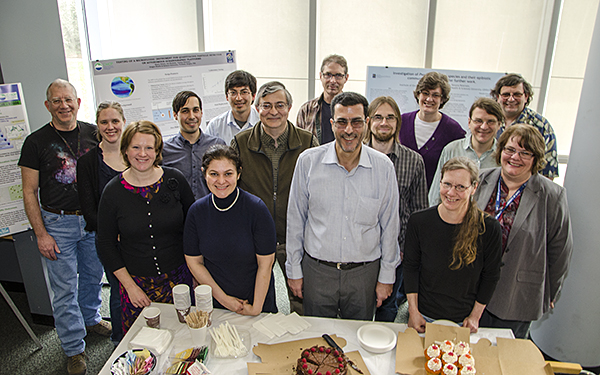You are here
Visiting Scholar Returns to United Arab Emirates
03/25/13 Portland, Ore.
Nabil Abdel Jabbar, Ph.D. recently concluded a sabbatical with the Center for Coastal Margin Observation & Prediction (CMOP).
 Antonio Baptista, Paul Turner, Tuomas Karna, Amy Johnson, Charles Seaton, Jim MohanDr. Jabbar is a professor of chemical engineering at American University of Sharjah (AUS) in the United Arab Emirates. His research focus is on process modeling, simulation and control of environmental and water quality systems.
Antonio Baptista, Paul Turner, Tuomas Karna, Amy Johnson, Charles Seaton, Jim MohanDr. Jabbar is a professor of chemical engineering at American University of Sharjah (AUS) in the United Arab Emirates. His research focus is on process modeling, simulation and control of environmental and water quality systems.
As a visiting scholar, Dr. Jabbar spent his sabbatical working closely with several scientists to better understand the computational models and observation network developed by CMOP.
“Nabil worked a lot with us on setting up high resolution simulations for the Northwest Pacific coast and analyzing the results,“ said Tuomas Karna, Ph.D., CMOP computational modeler and post-doctoral fellow in the lab of Dr. António Baptista. “He gained experience in mesh generation, setting up and running the software model, and post-processing the data.”
One of the accomplishments during his visit was to develop a three-dimensional simulation circulation model for the Pacific Ocean continental shelf off the Oregon and Washington coasts.
“We built a new simulation for the shelf to explore more about salt intrusions and gradients and see if we can improve detection of wind driven coastal upwelling and formation of small scale eddies on the sea surface,” Jabbar said.
He will take back the knowledge and experience to AUS and their new environmental center, Gulf Ecosystems Research Center (GERC). The center will monitor and conduct research on Gulf ecosystems and offer advice on long-term solutions to ecological problems.
Dr. Jabbar would like to see AUS develop models for the Arabian Gulf that helps with predictions, such as red tides. That region of the world relies heavily on water desalination for agricultural production and drinking water. Environmental events like red tides can disrupt that process.
“By using modeling to predict when a red tide will occur, we may be able to prevent damage to water processing plant membranes that filter the salt water,” Jabbar said. “If we can build a simulation model of the gulf, it will have a positive impact on the region and the entire country.”
Although Dr. Jabbar has resumed his teaching and research responsibilities at AUS, he and his university will continue to collaborate with CMOP.
Written by Jeff Schilling
###
ABOUT CMOP
The Center for Coastal Margin Observation & Prediction (CMOP) advances scientific understanding of the coastal margin environments that sustain much of the world's population. As a multi-institutional National Science Foundation Science and Technology Center, CMOP characterizes complex physical and biogeochemical processes at work in river-to-ocean ecosystems and explores links between environmental and human health. The center is a collaborative effort of many academic and industry partners, lead by Oregon Health & Science University (host institution), Oregon State University, and University of Washington.
ABOUT AMERICAN UNIVERSITY OF SHARJAH
Founded in 1997 by His Highness Sheikh Dr. Sultan Bin Mohammad Al Qassimi, Member of the Supreme Council of the United Arab Emirates and Ruler of Sharjah, the American University of Sharjah was envisaged by His Highness as a leading educational institution in the Gulf region. Consciously based upon American institutions of higher education, AUS is thoroughly grounded in Arab culture and is part of a larger process of the revitalization of intellectual life in the Middle East. We are an independent, not-for-profit coeducational institution that is proud of its role as a leading comprehensive coeducational university, serving students from the region and around the world.






